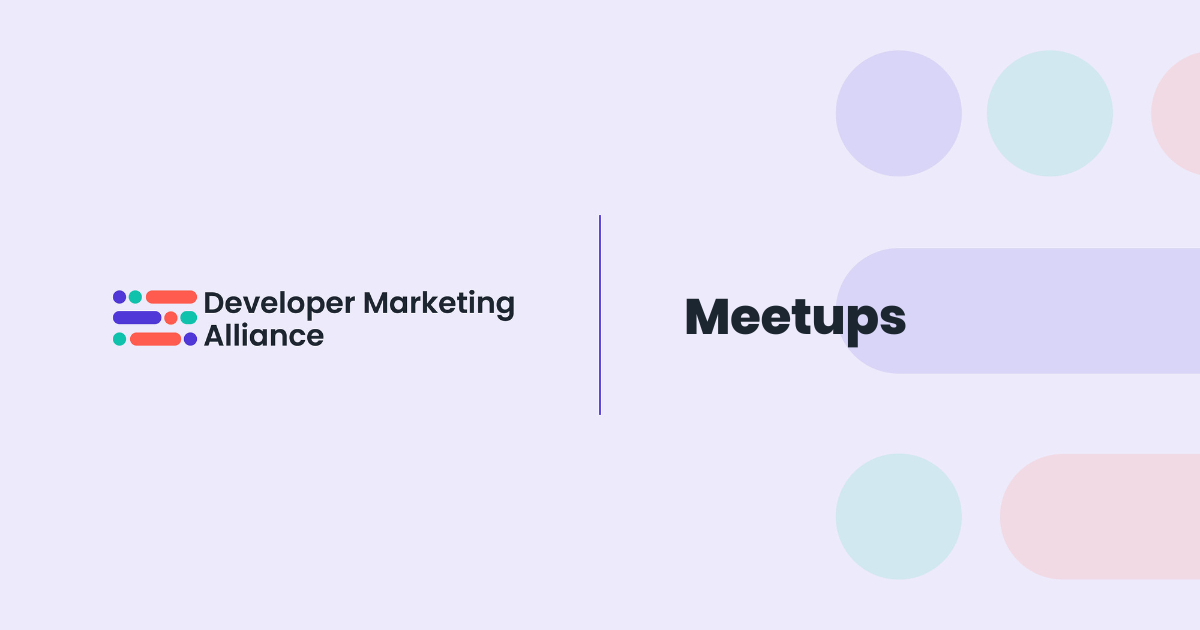The saying goes: "Innovation is important, but sometimes the answer lies in utilizing existing resources." As the tech industry continues to grow and evolve, marketing to developers has become increasingly important. However, standing out in this competitive space can be challenging.
As someone who is passionate about marketing to developers, I often ask myself, "How can I make my developer marketing strategy truly shine?"
While there are many strategies and techniques out there, sometimes the answer lies in utilizing existing resources. The key is not to try anything new but to learn how to use and think about what you already know as strategy as tools.
I call them the developer marketing arsenal; a comprehensive set of strategies that I see as tools to help you successfully market your products.
I'll be taking a deep dive into the key elements of a successful developer marketing strategy, so get your notepad ready, and let's arm ourselves with the tools we need to make our mark in the tech world.
What is developer marketing & what makes a developer marketable?
Developer marketing is a type of marketing that targets software developers, IT professionals, and other tech-savvy individuals. It involves promoting technology products and services to this audience and requires a deep understanding of the industry and the target audience.
Developers are highly sought after in today's job market, and companies are always looking for top talent. But what makes a developer marketable? In addition to technical skills, there are several other qualities that make a developer stand out. These include:
- Communication skills: Developers who can effectively communicate technical information to non-technical stakeholders are highly valued in the industry.
- Creativity: Developers who can think outside the box and come up with innovative solutions to problems are highly sought after.
- Collaborative skills: Developers who can work well in teams and collaborate effectively with others are highly valued.
- Adaptability: Developers who can quickly adapt to new technologies and programming languages are highly marketable.
By understanding what makes developers marketable, developer marketers can better target their audience and create effective marketing strategies that resonate with this unique audience.

5 things to remember while marketing to developers
Understanding the developer mindset
To effectively market to developers, it is crucial first to understand their unique mindset. Developers are highly analytical and logical individuals who prioritize functionality and efficiency above all else.
They are often highly skilled problem-solvers and enjoy the process of building and creating. As a developer marketer, it is vital to understand and appreciate this mindset to connect with developers effectively.
Some tips for connecting with developers include showcasing the functionality and efficiency of your product, providing detailed technical information, and highlighting the ability to solve specific development challenges.
Moreover, creating a community and engaging with developers collaboratively and transparently can help build trust and establish your brand as a valuable resource within the development community.
Developing a comprehensive marketing plan
A well-crafted marketing plan should identify the target audience, outline key messaging, and determine the best channels to reach that audience.
When creating a marketing plan for developers, keeping their unique mindset and tailoring messaging to speak directly to their needs and interests is essential.
This might involve showcasing the technical capabilities of a product, providing detailed documentation and tutorials, and highlighting how the product can solve specific development challenges.
In addition to crafting compelling messaging, selecting the proper channels to reach developers is critical.

This might include social media platforms like Twitter and LinkedIn, online forums and communities, and relevant industry events and conferences. Developing a comprehensive marketing plan can be time-consuming and iterative, but doing so can significantly improve engagement and conversion rates among developers.
Choosing the right channels
Choosing the right marketing channels is crucial for effectively reaching and engaging with developers.
There are several channels available, including social media, email marketing, events, and content marketing. Each channel has its pros and cons, and the best approach depends on your developer marketing strategy's specific needs and goals.
For example, social media platforms like Twitter and LinkedIn can be great for building brand awareness and engaging with the developer community.
Meanwhile, email marketing can be more effective for promoting specific products or services to a targeted audience. It's essential to consider factors such as budget, target audience, and message when choosing the right channels for your developer marketing campaign.
By understanding the strengths and weaknesses of each channel and aligning them with your marketing goals, you can develop an effective marketing plan that connects with developers most effectively.

Building a strong brand
Building a strong brand is a critical element of successful developer marketing. A strong brand can help differentiate your company from competitors, establish trust with your audience, and drive engagement and loyalty.
To build a strong brand, you must define your brand values, create a clear mission statement, and develop a brand identity that resonates with your target audience. You can reinforce your brand through consistent messaging, imagery, and voice across all marketing channels.
Additionally, it's essential to establish a consistent tone and voice that aligns with your brand values, which can help build trust with your audience and create a strong emotional connection.
With the right approach, building a strong brand can help you achieve long-term success in your developer marketing efforts.
Nurturing relationships with developers
Developers are a highly valuable audience for businesses looking to market their products or services.
However, building relationships with developers requires more than just selling them the features of your product. Taking a long-term approach to engagement and relationship-building is important, focusing on providing real value and listening to feedback.
Doing so can build trust and credibility with your audience, leading to stronger relationships and a better reputation in the developer community. Tips for nurturing relationships include:
- Providing educational resources.
- Engaging with developers on social media.
- Participating in industry events and communities.
Businesses can ensure long-term success in the developer market by taking a thoughtful and strategic approach to relationship-building.

3 secret weapons of developer marketing
By understanding how to leverage these tools and strategies, you can develop highly effective campaigns that raise awareness and build your brand in the developer community.
So, let's take a closer look at some of the key elements of the Arsenal, including technical documentation, open source, and newsletters.
1. Technical documentation as a marketing tool
As a developer marketer, we all know the importance of connecting with developers and demonstrating the value of your software. Technical documentation is an essential aspect of any software development project, but it can also be a powerful marketing tool.
Using technical documentation as a marketing tool
Technical documentation can be used to demonstrate software functionality and capabilities. By providing clear and detailed documentation, developers can quickly understand what the software can do and how it can solve their problems.
This can be especially effective for software companies that are competing in crowded markets, where potential customers need to quickly understand the benefits of the product.
Additionally, technical documentation can be used to showcase a software company's expertise and knowledge. By providing high-quality documentation, software companies can demonstrate that they are experts in their field and that their products are of high quality.
This can help build trust with potential customers, making it more likely that they will choose the company's software over a competitor's.
Technical documentation can also be used to improve the customer experience. Clear and concise documentation can reduce the number of support calls and emails that software companies receive, as developers are better able to troubleshoot issues on their own.
This can improve customer satisfaction, as developers are able to quickly and easily find the information they need to use the software effectively.
Finally, technical documentation can be used to upsell customers on additional products or services. By providing detailed documentation on advanced features or add-ons, software companies can encourage developers to upgrade their software or purchase additional products or services.
This can be an effective way to increase revenue and build long-term relationships with customers.

Understanding the target audience
To effectively use technical documentation as a marketing tool, it's important to understand the needs and preferences of developers. Developers are often pressed for time and want to quickly find the information they need.
Identifying pain points and challenges faced by developers can help you create technical documentation that caters to their needs.
Customizing technical documentation to cater to the target audience is very important. Developers are often looking for specific information, and technical documentation should be structured and labeled in a way that makes it easy to find that information.
Incorporating examples and tutorials can also help developers quickly understand how to use the software.
Best practices for technical documentation
Providing clear and concise documentation is essential. Developers don't have time to sift through lengthy or confusing documentation. Technical documentation should be structured in a way that makes it easy to skim and find relevant information quickly.
Using a consistent and structured approach to technical documentation is also important. Developers should be able to easily navigate through the documentation and find the information they need.
Ensuring that technical documentation is up-to-date is essential. Developers rely on technical documentation to help them understand and use the software effectively. Outdated documentation can lead to confusion and frustration, ultimately hurting the customer experience.
Most companies face some level of issues with documentation, not because they don't try hard to document everything they are building but because they need to know what type of content to create or how to organize it.
Daniel Procida's documentation system approach is particularly effective in building and organizing content. This system states that there are four types of content within the documentation that have specific functions for developers:
- Tutorials are great at getting developers started. They are a key element of the developer experience.
- How-to guides teach developers how to solve a particular problem.
- Technical references (like OpenAPI documentation) exhaustively describe everything your API or tools can do.
- Explanations make the case around your technical decision and aim to persuade a developer that it's the best solution.
Promoting technical documentation
Incorporating technical documentation in marketing campaigns is an effective way to promote it to developers. Sharing technical documentation on social media and developer communities can also help developers discover it.
Encouraging user feedback and incorporating it into the documentation can also help improve the quality and effectiveness of the documentation.
Important note: Seeing technical documentation as investment
Technical documentation is an essential aspect of software development, but it can also be a powerful marketing tool.
By providing high-quality technical documentation, software development companies can demonstrate the value of their software, showcase their expertise, improve the customer experience, and increase revenue.
As a developer marketer, investing in high-quality technical documentation can help you connect with developers and demonstrate the value of your software.
By understanding the needs and preferences of developers and customizing technical documentation to cater to their needs, you can create documentation that is both effective and efficient.
Ultimately, technical documentation is an investment that can pay off in many ways. By providing high-quality technical documentation, you can improve customer satisfaction, increase revenue, and demonstrate your expertise in the field.
As a developer marketer, technical documentation should be a key part of your marketing strategy. By investing in high-quality technical documentation, you can connect with developers and showcase the value of your software.
Example
Let’s take an example and understand more about what we have discussed. When we say, 'Technical references should exhaustively describe everything your API or tools can do,' what do we mean?
Kelsey Hightower, the Developer Evangelist at Google recently posted about what he thinks API docs should look like.
While the primary focus of Google’s documentation is very detailed code examples, DigitalOcean focused on UI and making it easier to find information. It’s not that DigitalOcean’s documentation is not detailed, it's about the primary focus at the first glance.
Here’s a personalized table with examples of companies with good product or technical documentation:
These companies have set the standard for high-quality technical documentation, providing clear and concise resources that help developers get up and running quickly. By taking a cue from their documentation practices, companies can better connect with their target audience and demonstrate the value of their products.
With the examples above, the summary comes down to a couple of things:
- You need to have an extensive technical documentation site full of information on your products and services.
- The site should be well-organized and easy to navigate, making it a valuable resource for developers who want to learn about your products.
- The documentation should be frequently updated, so developers can be confident they're always getting the most up-to-date information.
2. Open Source as a marketing strategy
Personal disclaimer: As a developer marketer, I've come to appreciate the power of open source as a marketing strategy. However, it's important to keep in mind that there's a fine balance between promoting your product and being overly aggressive in the open-source community.
In my experience, open-source developers are a unique group of individuals who value freedom and collaboration. They have a keen eye for recognizing valuable software and often have a strong sense of loyalty to the projects they contribute to. As such, it's important to approach the community with respect and caution.
Rather than focusing on direct sales, I suggest using open-source to create awareness about your product. Allow developers to explore your software and decide for themselves whether it's a good fit for their needs. If they're interested in learning more, they'll make it known.
It's important to remember that open source is not a silver bullet solution for sales. It's a tool to help build credibility and trust with the developer community. Overuse or misuse of open source can quickly turn off potential customers and harm your brand.
In short, use open source as a marketing strategy with care and purpose. Be respectful of the community and always prioritize their needs over your own sales goals. If done correctly, open source can be a powerful tool to help grow your developer community and promote your brand.

I know that’s a big disclaimer, and the reason is simple. It's essential for me to provide clarity and ensure that you don't end up in situations that may harm your company and brand.
Understanding open source
First, let's define what we mean by open source. Open source refers to software that is freely available and can be used, modified, and distributed by anyone. Open-source projects are typically collaborative efforts where developers work together to create software that is freely available to the public.
Open source has many advantages. It allows developers to collaborate and innovate together, leading to faster development and better software. It also allows developers to freely use and modify software, reducing the need to reinvent the wheel for every project.
Finally, open source promotes transparency and accountability, as the source code is publicly available and can be scrutinized by anyone.
Benefits of open source for developer marketing
Now that we understand what open source is, let's talk about the benefits of open source for developer marketing:
Building credibility and trust
By contributing to open source projects, developer marketers can build credibility and trust with developers. Developers are more likely to trust a company that is actively contributing to open source projects than a company that keeps their code proprietary.
Encouraging collaboration and innovation
Open-source projects encourage collaboration and innovation. By working on open source projects, developers can learn from each other, share knowledge, and build better software together.
Developer marketers can use open source to encourage collaboration and innovation, leading to a better product and a more engaged developer community.

Reaching a larger developer community
Open source projects are typically publicly available and widely used. By contributing to open-source projects, developer marketers can reach a larger developer community than they would by simply marketing their own products.
Getting feedback and improving products
Open source projects allow developers to provide feedback on software and suggest improvements. Developer marketers can use open-source projects to get feedback on their products and improve them based on the suggestions they receive.
Recruiting developers
Finally, open-source projects can be used to recruit developers. By contributing to open-source projects, developer marketers can find talented developers who may be interested in working for their company.
Using open source as a marketing strategy
Now that we understand the benefits of open source for developer marketing, let's talk about how to use open source as a marketing strategy.
Open-source software can give companies a competitive advantage by increasing visibility, thought leadership, and product and service quality. Additionally, open source can be used to build relationships with other companies and individuals, creating a positive feedback loop of collaboration and innovation.
Moreover, open source software can help improve the quality of a company's products and services. Open-source projects are often well-maintained and have high standards for code quality.
Companies can save time and money by using these projects as dependencies or starting points for new products while still delivering high-quality products to their customers.

Choosing the right open-source license
This is critical. There are many different types of open source licenses, each with its own advantages and disadvantages. Developer marketers should choose a license that allows for the appropriate level of control over their code while still encouraging collaboration and innovation.
Contributing to existing open-source projects
Contributing to existing open source projects is a great way to start. By doing so, developer marketers can build credibility and trust with the developer community while also learning from other developers and contributing to a larger project.
Creating new open-source projects
Creating new open source projects is another option. By creating new projects, developer marketers can build their own community of developers and promote their products in the process.
Hosting hackathons and meetups
Hosting hackathons and meetups is another way to use open source as a marketing strategy. By hosting events, developer marketers can bring developers together to work on open source projects and learn from each other.

Providing documentation and support
Finally, providing documentation and support for open source projects is critical. The one we had discussed in the section above as arsenal #1. Developer marketers should ensure that their open source projects are well-documented and provide adequate support to users.
This will help developers adopt and use the software, leading to a more engaged community and better feedback.
Challenges and risks of open-source marketing
While open source can be a powerful marketing strategy, it's important to be aware of the challenges and risks associated with open source marketing.
Managing community contributions
One challenge of open-source marketing is managing community contributions. Open-source projects can attract many contributors, some of whom may have different goals or agendas than the company promoting the project.
Developer marketers must be prepared to manage these contributions and ensure that the project stays aligned with their goals.
Maintaining product consistency
Another challenge of open-source marketing is maintaining product consistency. Open source projects can be modified by anyone, which can lead to inconsistencies and deviations from the company's vision.
Developer marketers must be prepared to manage these deviations and ensure that the project stays true to their goals.
Dealing with competitors
Finally, open-source projects can attract competitors. Competitors may try to take advantage of the project and use it to promote their own products.
Developer marketers must be prepared to deal with competitors and ensure that the project remains focused on their own goals.
Examples of successful open-source marketing
Despite these challenges, many companies have successfully used open source as a marketing strategy.
Here's a personalized table with companies that started as open source projects and have since been successful, with their open source project name, marketing campaigns, and industry:
These companies have used a variety of marketing campaigns, from conferences and summits to advertising campaigns, to promote their open source projects and enterprise offerings.
They span across different industries such as enterprise software, infrastructure automation, database management, and more.
3. Newsletters as a marketing strategy
Newsletters have become a popular marketing strategy for companies looking to connect with developers. These newsletters offer a personalized and direct way to share valuable content with your audience.
By delivering targeted information to developers' inboxes, companies can build relationships with their audience and establish themselves as thought leaders.
Additionally, newsletters can keep developers up-to-date on new product releases, feature updates, and other company news. With the right content and strategy, newsletters can be a powerful tool in any developer marketer's arsenal.
Benefits of newsletters for developer marketers
Newsletters can be a powerful tool for developer marketers, providing direct communication to potential and current customers.
- Build brand awareness: One of the key benefits of newsletters is their ability to build brand awareness and trust through consistent, valuable content.
- Building and nurturing relationships: Newsletters allow developer marketers to connect with their audience regularly, providing valuable insights and updates about the industry. This helps to build trust and establish a relationship between the marketer and the developer.
- Increasing engagement: Newsletters provide an opportunity to engage with the developer audience in a personalized way, which can lead to increased interaction, clicks, and, ultimately, conversions. They can also help drive traffic to a company's website or blog, provide updates on product or service releases, and offer exclusive promotions or discounts
- Establishing thought leadership: By sharing valuable insights and expertise in a newsletter, developer marketers can position themselves as thought leaders in the industry, which can help to build credibility and trust with their audience.
- Customize messaging: With the ability to personalize content and track engagement metrics, newsletters allow developer marketers to tailor their messaging to the needs and interests of their audience, ultimately leading to increased conversions and sales.
- Generating leads: Newsletters can also be a powerful lead generation tool, as they allow marketers to promote their products or services in a non-intrusive way while still providing value to the reader.
- Cost-effective: Unlike other marketing strategies, newsletters are a relatively low-cost option that can provide significant returns in engagement and conversions.
- Strengthens community: Newsletters can foster a sense of community among subscribers, encouraging engagement and feedback that can be used to refine and improve future marketing efforts.

Types of newsletters for developer marketing
- Curated content newsletters: These newsletters provide a selection of curated content from various sources, including blog posts, articles, and news stories related to the industry. These newsletters can help establish thought leadership and build relationships with subscribers.
- Product updates and announcements newsletters: These newsletters keep subscribers updated on the latest product updates, new features, and announcements related to the company's products and services. Newsletters are an effective way to keep customers engaged and interested in the company's products.
- Educational newsletters: These newsletters provide educational content, such as tutorials, case studies, and best practices, to help subscribers learn more about the industry and the company's products and services. They help establish the company as a thought leader in the industry and build trust with subscribers.
- Event and conference newsletters: These newsletters provide information about upcoming industry events and conferences, as well as insights and highlights from past events. They can help the company stay top-of-mind with subscribers and demonstrate the company's involvement in the industry.
Best practices for creating a newsletter for developer marketing
- Understanding your audience: It's important to know your target audience and what they are interested in. This can help you choose the right content mix and tone for your newsletter.
- Choosing the right content mix: The content mix of your newsletter should include a balance of industry news, educational content, product updates, and promotional content. The content should be relevant, informative, and engaging.
- Creating engaging and valuable content: Your newsletter content should be well-written, visually appealing, and offer value to your subscribers. This can include providing insights, tips, and best practices related to the industry.
- Designing for readability and accessibility: Your newsletter design should be easy to read and accessible on different devices, including desktop and mobile. Use clear fonts, colors, and layout to make the content easy to consume.
- Optimizing for mobile devices: A significant portion of subscribers will be reading your newsletter on mobile devices, so it's important to ensure your newsletter is optimized for mobile. This includes using a responsive design and formatting the content for easy reading on a small screen.
- Measuring and analyzing performance: It's important to track the performance of your newsletter, including open rates, click-through rates, and conversions. This can help you identify areas for improvement and optimize your newsletter for better results.
Here's an example of a comprehensive list of newsletters that I think are good examples and should work as a source of inspiration for you. I’ve categorized them and added examples for each:
My final thoughts
As a passionate advocate of developer marketing, I firmly believe that standing out in this industry requires a fresh and innovative approach. And the good news is, you don't always need to reinvent the wheel.
By taking advantage of existing resources and tools like technical documentation, open source, and newsletters, you can build a highly effective marketing arsenal that resonates with developers and sets you apart from the competition.
As you continue to refine your developer marketing strategy, remember that authenticity and transparency are key. Developers can smell marketing from a mile away, so it's important to focus on providing real value and building trust with your target audience.
By doing so, you'll not only gain their attention and trust, but also their loyalty.
So, take the time to explore these secret strategies and see how you can incorporate them into your marketing campaigns.
And remember, success in developer marketing is all about being creative, authentic, and strategic. With these three strategies in your arsenal, you'll be well on your way to building a strong and lasting presence in the developer community.
Want to read more from Sachin Jha? Here's his article on why advertising to developers isn't a bad idea if you do it the right way!





